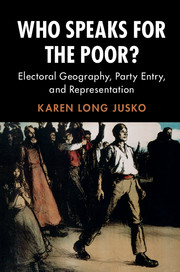Book contents
- Frontmatter
- Dedication
- Epigraph
- Contents
- List of Figures
- List of Tables
- Preface and Acknowledgments
- 1 Who Speaks for the Poor?
- 2 How Electoral Geography Matters
- 3 New Parties and the Changing Electoral Geography of Contemporary Democracies, 1880–2000
- 4 The Populists and “Third-Party Men” in America
- 5 Strategic Entry of the CCF and Social Credit in Canada
- 6 The Implications of Electoral Geography for British Labour
- 7 The Swedish Social Democratic Party, and the Long-Term Implications of Electoral Reform
- 8 “It Didn't Happen Here”: The General Implications of Electoral Geography for the Political Representation of the Poor
- References
- Index
- Miscellaneous Endmatter
2 - How Electoral Geography Matters
Published online by Cambridge University Press: 05 September 2017
- Frontmatter
- Dedication
- Epigraph
- Contents
- List of Figures
- List of Tables
- Preface and Acknowledgments
- 1 Who Speaks for the Poor?
- 2 How Electoral Geography Matters
- 3 New Parties and the Changing Electoral Geography of Contemporary Democracies, 1880–2000
- 4 The Populists and “Third-Party Men” in America
- 5 Strategic Entry of the CCF and Social Credit in Canada
- 6 The Implications of Electoral Geography for British Labour
- 7 The Swedish Social Democratic Party, and the Long-Term Implications of Electoral Reform
- 8 “It Didn't Happen Here”: The General Implications of Electoral Geography for the Political Representation of the Poor
- References
- Index
- Miscellaneous Endmatter
Summary
This chapter examines why and how changing electoral geography creates new opportunities for party formation. In particular, this chapter addresses the questions of when political entrepreneurs will form new parties, and which groupsthey will represent in a general theoretical argument. Implications from this general account will motivate a broadly comparative analysis of all new party entry in the next chapter, and then will be applied to the specific case of low-income voters: Under which conditions will political entrepreneurs recruit candidates to represent the interests of the poor? This chapter will argue that what matters, for the partisan and political representation of low-income voters, is how income groups are geographically distributed across electoral districts, and how this geographic distribution changes during crucial periods of migration and immigration.
Before proceeding, it is helpful to situate the argument presented here in the context of existing research on party formation and entry.
Stokes (1999a) addresses the question of when new parties form by distinguishing answers developed in the “comparative sociology of politics” literature from the answers developed in the institutional analysis of comparative political economists. Largely following Lipset and Rokkan (1967), political sociology explanations emphasize the long-term effects of social cleavages and alliances during crucial periods of transition, especially the Reformation and the Industrial Revolution. Parties, in this account, reflect the preferences of more-or-less well-defined coalitions in a society. More recent party formation, particularly green parties and extreme right parties, is attributed to the changing preferences of voters, and the inability of established parties to accommodate these new preferences (e.g., Aldrich 2011, Kitschelt et al. 1999, Inglehart 1997). Rosenstone, Behr, and Lazarus (1984) similarly emphasize changes in citizen demands in their account of American third parties. Understanding which groups are represented in party politics, in comparative sociological accounts, therefore, requires an accounting of major social cleavages, citizen preferences, and attitudes. And, within this tradition, the answer to the question of when new parties form is that they emerge when voters’ preferences shift so dramatically that new cleavages arise.
One limitation of the “up-from-the-bottom” explanations, as Kalyvas (1996) and Stokes (1999a) note, are their failures to take into account the costs and strategic incentives of those who do the work of organizing and mobilizing.
- Type
- Chapter
- Information
- Who Speaks for the Poor?Electoral Geography, Party Entry, and Representation, pp. 16 - 29Publisher: Cambridge University PressPrint publication year: 2017



